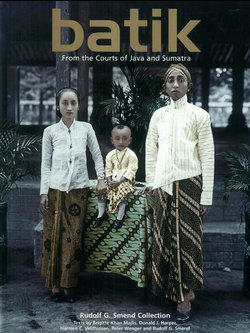Читать книгу Batik: From the Courts of Java and Sumatra - Rudolf G. Smend - Страница 8
ОглавлениеJavanese Batik: An Introduction
Brigitte Khan Majlis
Most of the batik textiles shown in this book date from the period between 1880 and 1930. This marked the peak of the art of Javanese batik dyeing which can be divided into two main areas and types: the batik tradition of Central Java and that of the north coast of Java. The batik of these two regions evolved under different conditions each serving different purposes. The textiles therefore show very different characteristics both in the design and usage.
Batik of Central Java
A highly sophisticated court culture developed at the royal courts of Central Java from as early as the thirteenth century which encouraged the supremacy of the aristocracy. The latter forged its identity through an elaborate system of customs ceremonies dress codes insignia and even the use of its own language. These factors all served to indicate differences in status and to distinguish one person from another. The court (kraton) of the sultan with the ruler at the top was the center where power was concentrated. The closer one was to this elite the higher one's standing in society.
In the seventeenth century the rulers of Surakarta and Yogyakarta issued decrees which made it obligatory to wear batik dress at court. In addition to the common use of the colors blue and white they stipulated soga brown—a kind of crowning glory. This led to the characteristic threesome of cream dark blue and brown in Central Javanese batik.
Certain designs were reserved for the sultan and his relatives including the powerful diagonal parang rusak design (Pls. 9, 14, photo pp. 2-3) and kawung motif formed with circles (Pl. 49) as well as stylized depictions of Garuda a mythical bird and the mount of the Hindu god Vishnu (Pls. 14, 19). Even today these design conventions are respected and outsiders do not enter the palace district or the compound wearing clothes with this ornamentation.
The surviving court dress consists of a kain panjang, literally "long cloth," a rectangular hip cloth worn by men and women (Pls. 17, 18) which is fastened with a belt at the waist. Women wrap a long narrow cloth (kemben) around their upper bodies leaving the shoulders bare (photo p. 25). The kemben textiles appear to belong to an older tradition. Apart from batik dyeing, kemben frequently show two additional reserve dye techniques: pelangi, a resist-dye technique which is used to create the elongated single color diamond (Pl. 5) or rectangle (Pl. 7) in the central section or tritik, a stitch-resist technique which creates delicate wavy outlines (Pl. 6). In many cases the central section is covered in brilliant dyed silk (Pls. 8, 12). Apart from their function as clothing somewhat smaller scale kemben are also used as ceremonial textiles gifts or sacrificial objects where the color combinations have an important role to play. However we are still lacking in-depth research about these smaller cloths.
A special hip cloth called a dodot, is worn during court ceremonies and sometimes by court dancers. It is four times as big as a normal hip cloth (Pls. 24-26 photo p. 10). Here too the central section often only has one color—white green dark violet—or is covered in silk. The outer edge may be decorated with batik or with an application of gold leaf or gold dust (prada) illustrating stylized animals of the forest. The bride and groom wear a dodot during the most important part of the wedding ceremony as they have exceptional status on that occasion (photo pp. 94-95).
Men cover their heads with a square batik cloth or iket kepala (Pls. 15, 16) which is artfully folded and which with the aid of a lining forms a tight-fitting cap (photo pp. 2-3). This use has largely disappeared although it is still possible to see old staff members of the kraton (palace) wearing this type of headgear.
The everyday use of batik dress among the wider population has only become common since World War II. Before this Javanese peasants tended to wear homemade striped or checked textiles in blue or black. Kain panjang is the dress of choice for celebrations and ceremonies as well as for less important social occasions.
